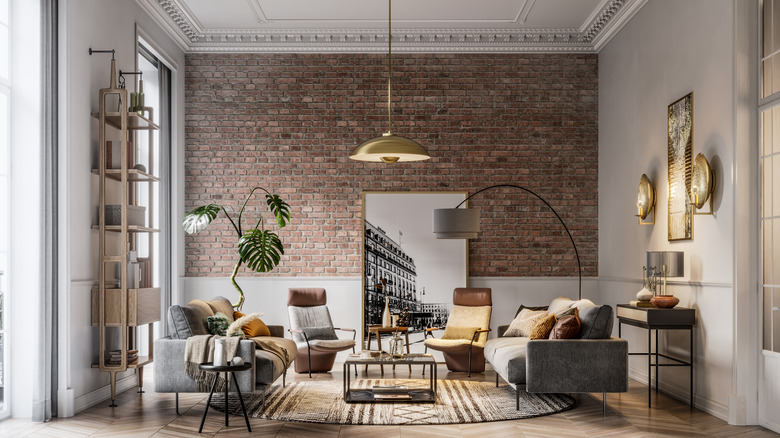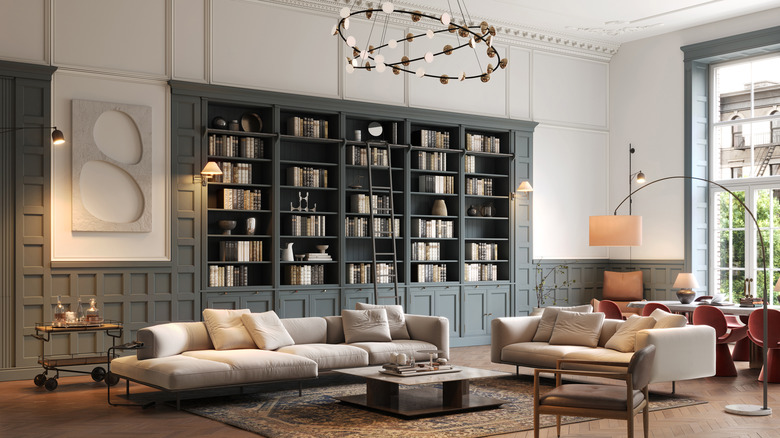Bobby Berk Reveals The Secret To The Perfect Living Room Lighting
The living room is the most essential hub of the home, as the spot where families gather on a daily basis and entertain guests. Made for conversation, connection, TV watching, relaxing, reading, family game night, and so much more, these living spaces work hard and wear multiple hats to suit our various needs. After so much time and energy goes into designing these spaces to be both practical and aesthetically-pleasing, though, it's scary to think how one lone factor could make or break the success of the space: a proper lighting plan to let your efforts shine and give the space proper functionality.
Thankfully, celebrity interior designer Bobby Berk has revealed that the secret to perfect living room lighting: creating multiple sources of light, that serve different purposes, to effectively light the space.
"I like to have three different types of lighting. They typically will consist of 'overhead lighting,' which will come from the overhead fixtures you have, 'diffused lighting' which can come in through a fabric lampshade or opaque glass shade, and 'task lighting' which will come from directional lamps or task lights," Berk told Homes & Gardens. Let's look deeper into Berk's pro tip to ensure your living room has the perfect lighting scheme to look and function its best.
Properly controlled overhead lighting creates the foundation of a well-lit living room
The first layer of light on Bobby Berk's ideal lighting plan for a living room space is overhead light, which is from ceiling-mounted sources such as recessed cans, chandeliers, or flush (or semi-flush) mount fixtures. This general lighting creates the relatively uniform backdrop of light that helps illuminate the overall space for functional purposes. However, intense overhead lighting can be too stark, harsh, or jarring, so be sure to choose softer warm white color temperature light bulbs (no more than 3000K — for the sake of eyeballs everywhere, stay away from cool white or daylight bulbs in a living space) and put them on a dimmer so you can control the output.
While it is sometimes necessary to utilize recessed cans (think deep cleaning on a rainy day), designers and homeowners are forgoing this outdated living room lighting trend that younger generations are calling "the big light" in favor of softer, more diffused sources of light that give the space more ambiance. Rather than relying on recessed cans for overhead lighting in living spaces, more people are opting for decorative overhead fixtures on dimmers, such as chandeliers and ceiling-mounted options, often with diffusers or shades incorporated into the design of the light. These decorative fixtures create a more aesthetically appealing overhead look — with better disbursement and control of light — to avoid that interrogation room vibe of improperly controlled big light syndrome.
Diffused and task lighting set the mood and create the functionality
The next — and arguably most important — layer of lighting on Bobby Berk's list is diffused lighting, which gets its namesake from the way these light sources spread out light through various types of shades to create a warm, soft glow: Think table lamps, floor lamps, art lights, and wall sconces. Not only do these diffused lights create a gorgeous atmosphere, but they also light up dark corners unaddressed by overhead lighting. As Bobby Berk told Homes & Gardens, this is a key element in his approach. In his words, "[Add] multiple focal points to your room to keep eyes bouncing around so it appears much bigger than it is."
Berk's final layer of lighting is task-related fixtures, which have a directional quality, or a more defined, focused light stream with a functional purpose, like a reading or desk lamp. In a living space, these are often floor lamps, sconces, small hanging pendants, or table lamps with a downward-facing bulb, often on an adjustable arm to allow the user to tailor the lighting to their task, such as a pharmacy reading lamp or pivoting sconce. Used for reading, writing, family puzzle time, and more, these task lamps are specific to your needs and give a boost of function in areas where you heavily use the space.
By following Berk's formula for a perfect living room lighting plan with all three sources of light, you will not only get the function you need and set a welcoming vibe, but you will also let your living room design really shine in proper, well-planned light.


